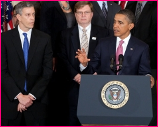Posted on October 2nd, 2011 by Mary Lord
 Despite decades of steadily climbing college enrollment rates, the percentage of students earning a degree or certificate on time has barely budged, a new study reveals. By including older and part-time students, the Complete College America report paints a more comprehensive picture of the gap between college aspirations and outcomes than federal data typically has captured.
Despite decades of steadily climbing college enrollment rates, the percentage of students earning a degree or certificate on time has barely budged, a new study reveals. By including older and part-time students, the Complete College America report paints a more comprehensive picture of the gap between college aspirations and outcomes than federal data typically has captured.
Read More
Filed under: K-12 Education News | Comments Off on More Start, Fewer Finish College
Tags: college completion, Complete College America, Education Policy, Public Policy, Time Is The Enemy
Posted on October 2nd, 2011 by Mary Lord
 After months of negotiations, the Senate education committee will take up a comprehensive bill reauthorizing the Elementary and Secondary Education Act. The markup is scheduled for Oct. 18. Meanwhile, the House has broken the reauthorization bill into bite-sized pieces and is expected to deal with the big issues of accountability and teacher quality this fall.
After months of negotiations, the Senate education committee will take up a comprehensive bill reauthorizing the Elementary and Secondary Education Act. The markup is scheduled for Oct. 18. Meanwhile, the House has broken the reauthorization bill into bite-sized pieces and is expected to deal with the big issues of accountability and teacher quality this fall.
Read More
Filed under: K-12 Education News | Comments Off on ESEA Reauthorization Back on Track?
Tags: Education Policy, ESEA, No Child Left Behind, Public Policy, Senate, Tom Harkin
Posted on September 25th, 2011 by Mary Lord
 Flanked by students, teachers, state education leaders, aPresident Barack Obama announced a plan to let states and districts waive some of the No Child Left Behind (NCLB) law’s most onerous requirements. In exchange, however, states would have to adopt certain reforms — including teacher evaluations that take student test scores into account.
Flanked by students, teachers, state education leaders, aPresident Barack Obama announced a plan to let states and districts waive some of the No Child Left Behind (NCLB) law’s most onerous requirements. In exchange, however, states would have to adopt certain reforms — including teacher evaluations that take student test scores into account.
Read More
Filed under: K-12 Education News | Comments Off on Do Waivers Signal End of “No Child” Era?
Tags: Education Policy, ESEA, NCLB, No Child Left Behind, Public Policy, waiver, White House
Posted on September 25th, 2011 by Jaimie Schock
 In a Sept. 12 Capitol Hill bid for increased federal funding, a panel of representatives from industry and non-profits mapped out their goals for the future of afterschool, informal education in the U.S. Among them, an enthusiastic Fernando Laguarda of Time Warner Cable explained the company’s programs and efforts, while also outlining the daunting tasks that lie ahead in a time of increasing budget constraints.
In a Sept. 12 Capitol Hill bid for increased federal funding, a panel of representatives from industry and non-profits mapped out their goals for the future of afterschool, informal education in the U.S. Among them, an enthusiastic Fernando Laguarda of Time Warner Cable explained the company’s programs and efforts, while also outlining the daunting tasks that lie ahead in a time of increasing budget constraints.
Read More
Filed under: K-12 Education News | Comments Off on Industry, Orgs. Champion Informal Education
Tags: After School, Corporations, Education Policy, Informal Learning, Public Policy
Posted on September 18th, 2011 by ASEE
 The federal government spends $3.5 billion a year, all told, on 252 science, technology, engineering and math (STEM) programs spread across 13 agencies. But “perhaps somewhat surprisingly,” there’s no wasteful overlap, a White House official says.
The federal government spends $3.5 billion a year, all told, on 252 science, technology, engineering and math (STEM) programs spread across 13 agencies. But “perhaps somewhat surprisingly,” there’s no wasteful overlap, a White House official says.
Read More
Filed under: K-12 Education News | 3 Comments »
Tags: Education Policy, Public Policy, STEM education
Posted on September 11th, 2011 by Mary Lord
 What prompts today’s undergraduates to pursue STEM majors rather than business, law, the arts, or other fields of study? Job prospects? Passion? How about you, and what they’re learning in your classroom? According to a new study, college students decide to concentrate in science, technology, engineering, and math in high school or before – and more than half cite “a teacher or class” as their top reason.
What prompts today’s undergraduates to pursue STEM majors rather than business, law, the arts, or other fields of study? Job prospects? Passion? How about you, and what they’re learning in your classroom? According to a new study, college students decide to concentrate in science, technology, engineering, and math in high school or before – and more than half cite “a teacher or class” as their top reason.
Read More
Filed under: K-12 Education News | Comments Off on Students Set STEM Path Early
Tags: Harris poll, Public Policy, Science Teachers, STEM majors, STEM Perceptions, STEM teachers, why students pursue engineering
Posted on September 6th, 2011 by Mary Lord
 The Common Core State Standards just took a big step toward becoming classroom practice. Some 44 states and the District of Columbia adopted these new standards in English language arts and mathematics over the past year. Now, STEM teachers are getting the first details of the key content students must master when common assessments roll out in 2014.
The Common Core State Standards just took a big step toward becoming classroom practice. Some 44 states and the District of Columbia adopted these new standards in English language arts and mathematics over the past year. Now, STEM teachers are getting the first details of the key content students must master when common assessments roll out in 2014.
Read More
Filed under: K-12 Education News | Comments Off on Common Math Content Released
Tags: assessments, Common Core State Standards, Math, math content, math standards, Math teachers, Mathematics, PARCC, Public Policy, SMARTER Balanced consortium
Posted on August 28th, 2011 by Mary Lord
 Attention, STEM majors. The nation needs more middle and high school science teachers — and there are several new initiatives to encourage you to sign up for training. Indiana’s Valparaiso University, for instance, just received a $500,000 federal grant to train science undergraduates as educators. The program will include paid summer internships and student-teaching stints.
Attention, STEM majors. The nation needs more middle and high school science teachers — and there are several new initiatives to encourage you to sign up for training. Indiana’s Valparaiso University, for instance, just received a $500,000 federal grant to train science undergraduates as educators. The program will include paid summer internships and student-teaching stints.
Read More
Filed under: K-12 Education News | Comments Off on New Push for Science Teachers
Tags: education programs, National Science Foundation, Public Policy, STEM majors, STEM teacher training, Teacher Training, undergraduate
Posted on August 14th, 2011 by Jaimie Schock
 States will soon be able to opt out of No Child Left Behind though qualifying for special waivers offered by the Obama Administration. Citing a failure by Congress to make any progress on reforming the controversial legislation before the upcoming school year, the Department of Education will offer waivers to all 50 states, which will be expected to meet certain criteria in order to qualify.
States will soon be able to opt out of No Child Left Behind though qualifying for special waivers offered by the Obama Administration. Citing a failure by Congress to make any progress on reforming the controversial legislation before the upcoming school year, the Department of Education will offer waivers to all 50 states, which will be expected to meet certain criteria in order to qualify.
Read More
Filed under: K-12 Education News | Comments Off on States Offered NCLB Opt-Out Waivers
Tags: Education Policy, No Child Left Behind, Public Policy, U. S. Department of Education
 Despite decades of steadily climbing college enrollment rates, the percentage of students earning a degree or certificate on time has barely budged, a new study reveals. By including older and part-time students, the Complete College America report paints a more comprehensive picture of the gap between college aspirations and outcomes than federal data typically has captured.
Despite decades of steadily climbing college enrollment rates, the percentage of students earning a degree or certificate on time has barely budged, a new study reveals. By including older and part-time students, the Complete College America report paints a more comprehensive picture of the gap between college aspirations and outcomes than federal data typically has captured. 








 After months of negotiations, the Senate education committee will take up a comprehensive bill reauthorizing the Elementary and Secondary Education Act. The markup is scheduled for Oct. 18. Meanwhile, the House has broken the reauthorization bill into bite-sized pieces and is expected to deal with the big issues of accountability and teacher quality this fall.
After months of negotiations, the Senate education committee will take up a comprehensive bill reauthorizing the Elementary and Secondary Education Act. The markup is scheduled for Oct. 18. Meanwhile, the House has broken the reauthorization bill into bite-sized pieces and is expected to deal with the big issues of accountability and teacher quality this fall.  Flanked by students, teachers, state education leaders, aPresident Barack Obama announced a plan to let states and districts waive some of the No Child Left Behind (NCLB) law’s most onerous requirements. In exchange, however, states would have to adopt certain reforms — including teacher evaluations that take student test scores into account.
Flanked by students, teachers, state education leaders, aPresident Barack Obama announced a plan to let states and districts waive some of the No Child Left Behind (NCLB) law’s most onerous requirements. In exchange, however, states would have to adopt certain reforms — including teacher evaluations that take student test scores into account. In a Sept. 12 Capitol Hill bid for increased federal funding, a panel of representatives from industry and non-profits mapped out their goals for the future of afterschool, informal education in the U.S. Among them, an enthusiastic Fernando Laguarda of Time Warner Cable explained the company’s programs and efforts, while also outlining the daunting tasks that lie ahead in a time of increasing budget constraints.
In a Sept. 12 Capitol Hill bid for increased federal funding, a panel of representatives from industry and non-profits mapped out their goals for the future of afterschool, informal education in the U.S. Among them, an enthusiastic Fernando Laguarda of Time Warner Cable explained the company’s programs and efforts, while also outlining the daunting tasks that lie ahead in a time of increasing budget constraints. The federal government spends $3.5 billion a year, all told, on 252 science, technology, engineering and math (STEM) programs spread across 13 agencies. But “perhaps somewhat surprisingly,” there’s no wasteful overlap, a White House official says.
The federal government spends $3.5 billion a year, all told, on 252 science, technology, engineering and math (STEM) programs spread across 13 agencies. But “perhaps somewhat surprisingly,” there’s no wasteful overlap, a White House official says.  What prompts today’s undergraduates to pursue STEM majors rather than business, law, the arts, or other fields of study? Job prospects? Passion? How about you, and what they’re learning in your classroom? According to a new study, college students decide to concentrate in science, technology, engineering, and math in high school or before – and more than half cite “a teacher or class” as their top reason.
What prompts today’s undergraduates to pursue STEM majors rather than business, law, the arts, or other fields of study? Job prospects? Passion? How about you, and what they’re learning in your classroom? According to a new study, college students decide to concentrate in science, technology, engineering, and math in high school or before – and more than half cite “a teacher or class” as their top reason.  The Common Core State Standards just took a big step toward becoming classroom practice. Some 44 states and the District of Columbia adopted these new standards in English language arts and mathematics over the past year. Now, STEM teachers are getting the first details of the key content students must master when common assessments roll out in 2014.
The Common Core State Standards just took a big step toward becoming classroom practice. Some 44 states and the District of Columbia adopted these new standards in English language arts and mathematics over the past year. Now, STEM teachers are getting the first details of the key content students must master when common assessments roll out in 2014. Attention, STEM majors. The nation needs more middle and high school science teachers — and there are several new initiatives to encourage you to sign up for training. Indiana’s Valparaiso University, for instance, just received a $500,000 federal grant to train science undergraduates as educators. The program will include paid summer internships and student-teaching stints.
Attention, STEM majors. The nation needs more middle and high school science teachers — and there are several new initiatives to encourage you to sign up for training. Indiana’s Valparaiso University, for instance, just received a $500,000 federal grant to train science undergraduates as educators. The program will include paid summer internships and student-teaching stints.  States will soon be able to opt out of No Child Left Behind though qualifying for special waivers offered by the Obama Administration. Citing a failure by Congress to make any progress on reforming the controversial legislation before the upcoming school year, the Department of Education will offer waivers to all 50 states, which will be expected to meet certain criteria in order to qualify.
States will soon be able to opt out of No Child Left Behind though qualifying for special waivers offered by the Obama Administration. Citing a failure by Congress to make any progress on reforming the controversial legislation before the upcoming school year, the Department of Education will offer waivers to all 50 states, which will be expected to meet certain criteria in order to qualify.